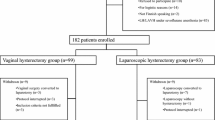Abstract
Introduction and hypothesis
Pre-emptive gabapentin has been shown to decrease postoperative pain in abdominal and vaginal hysterectomy. However, the effect of pre-emptive low-dose gabapentin has not been studied in vaginal hysterectomy combined with concomitant pelvic reconstruction.
Methods
A randomized double-blind placebo-controlled trial assessed all women seen for symptomatic prolapse requiring vaginal hysterectomy with concomitant pelvic reconstruction with or without midurethral sling. Gabapentin dosing was 600 mg (<65 years) or 300 mg (>65 years). The primary outcome was reduction in opioid consumption in the first 24 h after surgery. Secondary outcomes included sedation and prolongation of recovery room stay. Sample-size calculations indicated a need for 22 participants/group. Student’s t test was used to compare differences in oral administration of morphine equivalents in the first 24 h postoperatively, time from end of surgery to leaving the recovery room, and length of recovery room stay. Mann–Whitney U test was used to compare visual analog scale (VAS) scores for anxiety, drowsiness/sedation, pain, and nausea.
Results
Twenty-one patients received gabapentin and 26 a placebo capsule. Groups were similar with respect to age, menopause status, parity, American Society of Anesthesiologist (ASA) class, and concomitant procedures. There were also no significant differences between groups in opioid requirements within the first 24 h after surgery, time from end of surgery to leaving the recovery room, length of time in recovery room, or VAS scores.
Conclusions
Pre-emptive gabapentin at our institutional low doses did not significantly affect postoperative pain and opioid requirements in women undergoing vaginal hysterectomy with concomitant reconstruction.
Trial registration
www.clinicaltrials.gov, #NCT02999724.

Similar content being viewed by others
References
Alayed N, Alghanaim N, Tan X, Tulandi T. Pre-emptive use of gabapentin in abdominal hysterectomy. Obstet Gynecol. 2014;123:1221–9. https://doi.org/10.1097/AOG.0000000000000289.
Rorarius MGF, Mennander S, Suominen P, Rintala S, Puura A, Pirhonen R, et al. Gabapentin for the prevention of postoperative pain after vaginal hysterectomy. Pain. 2004;110:175–81. https://doi.org/10.1016/j.pain.2004.03.023.
Sills GJ. The mechanisms of action of gabapentin and Pregabalin. Curr Opin Pharmacol. 2006;6:108–13. https://doi.org/10.1016/j.coph.2005.11.003.
Peng PWH, Wijeysundera DN, Li CCF. Use of gabapentin for perioperative pain control – a meta-analysis. Pain Res Manag. 2007;12:85–92. https://doi.org/10.1155/2007/840572.
Penprase B, Brunetto E, Dahmani E, Forthoffer JJ, Kapoor S. The efficacy of pre-emptive analgesia for postoperative pain control: a systematic review of the literature. AORN J. 2015;101:105.e8. https://doi.org/10.1016/j.aorn.2014.01.030.
Dahl JB, Mathiesen O, Moiniche S. Protective Premedication': an option with gabapentin and related drugs?: a review of gabapentin and Pregabalin in the treatment of postoperative pain. Acta Anaesthesiol Scand. 2004;48:1130–6. https://doi.org/10.1111/j.1399-6576.2004.00484.x.
Yu L, Ran B, Li M, Shi Z. Gabapentin and Pregabalin in the Management of Postoperative Pain after Lumbar Spinal Surgery: a systematic review and meta-analysis. Spine. 2013;38:1947–52. https://doi.org/10.1097/BRS.0b013e3182a69b90.
Siddiqui NT, Yousefzadeh A, Yousuf M, Kumar D, Choudhry FK, Friedman Z. The effect of gabapentin on delayed discharge from the post anesthesia care unit: a retrospective analysis. Pain Pract. 2017; https://doi.org/10.1111/papr.12575.
Ramsay RE. Clinical efficacy and safety of gabapentin. Neurology. 1994;44:S23–30. discussion S31-2
Chang CY, Challa CK, Shah J, Eloy JD. Gabapentin in acute postoperative pain management. Biomed Res Int. 2014;2014:631756. https://doi.org/10.1155/2014/631756.
Acknowledgements
We are grateful to the perioperative nursing staff at Mount Sinai Hospital for their assistance in this study.
Funding
None.
Author information
Authors and Affiliations
Corresponding author
Ethics declarations
Conflict of interest
None.
Additional information
Presentations
Poster of interim analysis at the International Urogynecological Association’s Annual Meeting (Vancouver, British Columbia, Canada, 20–24 June 2017). Oral presentation of final results at the International Continence Society’s Annual Meeting (Florence, Italy, 12–15 September 2017). Oral presentation of final results at the American Urogynecologic Society’s Annual Scientific Meeting (Providence, RI, USA, 3–7 October 2017)
Rights and permissions
About this article
Cite this article
Li, A.L.K., Wadsworth, K., Siddiqui, N.T. et al. Does low-dose gapapentin reduce opioid use postoperatively?: A randomized controlled trial in women undergoing reconstructive pelvic surgery. Int Urogynecol J 30, 211–217 (2019). https://doi.org/10.1007/s00192-018-3617-3
Received:
Accepted:
Published:
Issue Date:
DOI: https://doi.org/10.1007/s00192-018-3617-3



